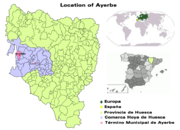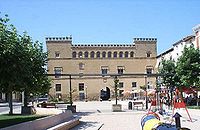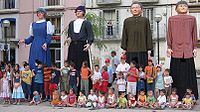
Ayerbe
Encyclopedia

Comarca
A comarca is a traditional region or local administrative division found in parts of Spain, Portugal, Panama, Nicaragua, and Brazil. The term is derived from the term marca, meaning a "march, mark", plus the prefix co- meaning "together, jointly".The comarca is known in Aragonese as redolada and...
, in the autonomous community
Autonomous communities of Spain
An autonomous community In other languages of Spain:*Catalan/Valencian .*Galician .*Basque . The second article of the constitution recognizes the rights of "nationalities and regions" to self-government and declares the "indissoluble unity of the Spanish nation".Political power in Spain is...
of Aragon
Aragon
Aragon is a modern autonomous community in Spain, coextensive with the medieval Kingdom of Aragon. Located in northeastern Spain, the Aragonese autonomous community comprises three provinces : Huesca, Zaragoza, and Teruel. Its capital is Zaragoza...
in Spain
Spain
Spain , officially the Kingdom of Spain languages]] under the European Charter for Regional or Minority Languages. In each of these, Spain's official name is as follows:;;;;;;), is a country and member state of the European Union located in southwestern Europe on the Iberian Peninsula...
.
Geography
Ayerbe is located 28 km from HuescaHuesca
Huesca is a city in north-eastern Spain, within the autonomous community of Aragon. It is also the capital of the Spanish province of the same name and the comarca of Hoya de Huesca....
on highway A 132 in the direction of Pamplona
Pamplona
Pamplona is the historial capital city of Navarre, in Spain, and of the former kingdom of Navarre.The city is famous worldwide for the San Fermín festival, from July 6 to 14, in which the running of the bulls is one of the main attractions...
, on the Gállego river. It is bounded by Riglos crags and the Santo Domingo range of hills to the north; to the east by the villages of Loarre and Loscorrales; to the south by the villages of Lupiñén-Ortilla, and to the west by the villages of Biscarrues and Murillo de Gállego. It is located at 42°16′36"N 00°41′21"W, with a height above sea level of Alicante
Alicante
Alicante or Alacant is a city in Spain, the capital of the province of Alicante and of the comarca of Alacantí, in the south of the Valencian Community. It is also a historic Mediterranean port. The population of the city of Alicante proper was 334,418, estimated , ranking as the second-largest...
of 582 m. and an area of 63.29 square kilometres. It is located in an excavated erosive depression in the surface of the Tertiary period.
The soil is dry, loose and stony, generally level with a sprinkling of small isolated hills. The land is largely covered by pines, olive and almond trees, with vineyards making a comeback. There are also areas of cereal production to the east and south. It is also populated by evergreen oaks, rosemary, gorse and other shrubs in addition to grass. There are occasional occurrences of rabbits, hares and partridges.
The area is particularly attractive to bird watchers, who come to see the lammergeier
Lammergeier
The Lammergeier, Lammergeyer, or Bearded Vulture, Gypaetus barbatus , is the only member of the genus Gypaetus. Traditionally considered an Old World vulture, it actually forms a minor lineage of Accipitridae together with the Egyptian Vulture , its closest living relative...
, griffon vulture
Griffon Vulture
The Griffon Vulture is a large Old World vulture in the bird of prey family Accipitridae.The Griffon Vulture is long with a wingspan. In the nominate race the males weigh and females typically weigh , while in the Indian subspecies the vultures average...
and Egyptian vulture
Egyptian Vulture
The Egyptian Vulture is a small Old World vulture, found widely distributed from southwestern Europe and northern Africa to southern Asia. It is the only living member of the genus Neophron. It has sometimes also been known as the White Scavenger Vulture or Pharaoh's Chicken...
s, as well as a wide variety of birds of prey. Hunters find plenty of wild boars and deer, as well as partridge and quail.
The hill range behind Ayerbe is part of the Pre-Pyrenees and reaches over 1,600 m, although the town itself is actually on the plain at the foot of the range, which eventually leads down to the River Ebro, around 100 km away.
Points of interest


Ayerbe's main claim to fame is that Santiago Ramón y Cajal
Santiago Ramón y Cajal
Santiago Ramón y Cajal ForMemRS was a Spanish pathologist, histologist, neuroscientist, and Nobel laureate. His pioneering investigations of the microscopic structure of the brain were original: he is considered by many to be the father of modern neuroscience...
, winner of the 1906 Nobel prize
Nobel Prize
The Nobel Prizes are annual international awards bestowed by Scandinavian committees in recognition of cultural and scientific advances. The will of the Swedish chemist Alfred Nobel, the inventor of dynamite, established the prizes in 1895...
in Physiology or Medicine, lived here for ten years. The town promotes his memory with a museum and visitor centre; Ayerbe library holds a collection of Cajal-related books with more than 250 works and documents for public use.
Ayerbe has a public library, casino, bars, municipal swimming pool and, around the town, a network of footpaths, fields and highways for walkers and cyclists. There are several restaurants, a hotel and bed and breakfast accommodation, as well as tourist information center in the summer months in one of the town squares. Other attractions include Fontaneta park (at 42°16′43"N 00°41′19"W) and the "La Fuente de los Tres Caños" fountain.
The hill directly behind the town is the location of a now renovated chapel at one end and a Moorish castle (in ruins) at the other. These can be reached on foot or by all terrain vehicle and provide excellent views of the surrounding countryside (even to the Pyrenees).
The town is known by many in the region for its "Tortas de Ayerbe", which are sweet flat, round pastries, usually flavoured with aniseed. Visitors can also purchase locally produced wine, olive oil and honey.
Fiestas and celebrations
The FiestaFiesta patronal
The Fiestas patronales are yearly celebrations held in countries influenced by Spanish culture.A fiesta patronal is usually dedicated to a saint or virgin, who is the patron of whichever city holds the fiesta. Usually, town members adorn the town streets with colorful decorations and other things...
of Santa Leticia
Saint Leticia
Saint Leticia , whose feast day is October 21, is venerated as a virgin martyr. A saint with the same name had a feast day occurring on March 13. Her cult was diffused in Corsica and can be found in medieval England...
takes place around September 9th and lasts for four to six days. A sculpture of the Saint is carried in procession, its pedestal garlanded with grapes; figures of giants
Giant (mythology)
The mythology and legends of many different cultures include monsters of human appearance but prodigious size and strength. "Giant" is the English word commonly used for such beings, derived from one of the most famed examples: the gigantes of Greek mythology.In various Indo-European mythologies,...
and "cabezudos" parade in the streets and pyrotechnic figures of bulls race through the town every night.
In 2005 the 6th meeting of the Giants of Aragon took place in the town, bringing together 72 giant figures from all over Aragon
Aragon
Aragon is a modern autonomous community in Spain, coextensive with the medieval Kingdom of Aragon. Located in northeastern Spain, the Aragonese autonomous community comprises three provinces : Huesca, Zaragoza, and Teruel. Its capital is Zaragoza...
: 32 bands, 166 musicians and 140 figure-carriers took part.
"The week of the mushrooms" has been celebrated in the town for years in the month of October and constitutes a social event on an international level.

